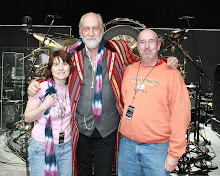And I'll admit, I got very attached to the Hollywood version, which basically totally changed the ending of the off-Broadway show -- both in content and tone. I understand why the test audiences didn't want Seymour and Audrey to die just after they had finally happiness with each other.
But I also appreciate the original director's cut, which was officially culled together in 2012 from unearthed bits and pieces of film from the vault. It's closer to the story concocted for the theater by Alan Menken and Howard Ashman, which in turn, is what Roger Corman strived for in the original 1960 black comedy. Having Audrey II burst through the screen at the end of the modern-day version plays like a stroke of genius. That should be experienced on a huge screen to be properly enjoyed.
 So to come full circle and see the movie the way director Frank Oz planned it to be seemed perfect. Sitting in the second row for a Q&A with Oz afterward would be like having a designer cupcake with me, and less fattening. So naturally, I had to make my way to the Schimmel Center at Pace University on Oct. 30 for the opportunity of a Little Shop fan's lifetime.
So to come full circle and see the movie the way director Frank Oz planned it to be seemed perfect. Sitting in the second row for a Q&A with Oz afterward would be like having a designer cupcake with me, and less fattening. So naturally, I had to make my way to the Schimmel Center at Pace University on Oct. 30 for the opportunity of a Little Shop fan's lifetime.First we watched the film. So much fun to applaud at the titles and at the end of each main song. (I mouthed the lyrics to every single one, obviously). The audience, most of whom probably weren't alive when the film was originally released, enjoyed every laugh -- particularly when Bill Murray arrived on the scene as the patient who enjoys dental procedures a wee bit too much. Everything he did and said got huge belly laughs. Also of note: They didn't seem to recognize Christopher Guest when he made a cameo as the first customer to see Audrey II.
Oz came out soon after the lights came up -- and it's startling to think about how much he's affected pop culture above and beyond this film. From Sesame Street to Yoda, he's long been apart of several generations' childhoods. But even the greatest don't always get their way, like when The Geffen Company called for a different ending to the movie. "No one wanted this ending because they loved Seymour and Audrey," Oz admitted. "It was a great lesson to me."
We learned the ins and outs of the making of Little Shop of Horrors, how all the tracks were recorded about a year before filming even started at Pinewood (aka the 007 stage). The songs were played back and Oz instructed his performers to lip sync perfectly ... or else. That proved particularly complicated in big numbers such as "Mean Green Mother from Outer Space," "Feed Me" and "Skid Row." The shot in which the camera rises from "Somewhere That's Green" to "Some Fun Now" also proved to be very trying. Put succinctly, Oz said, "The whole thing was a muther."
This "muther" was only Oz's second solo directing gig. He co-helmed The Dark Crystal with Jim Henson, basically on-the-job training, according to Oz, then handled The Muppets Take Manhattan, which he endearingly kept referring to as Muppet Guys Talking -- the name of the 2017 documentary featuring all five of the original Muppets performers. He originally said no to Little Shop because Oz didn't think he'd be able to handle 12 songs, a variety of guest stars and the burgeoning greenery.

Two main things changed his mind. The teenage chorus -- Tichina Arnold, Tisha Campbell and Michele Weeks -- and the realization that the whole thing was supposed to be silly, like the B-movie the original hailed from. "The girls opened it up for me, I knew I could bop them around," Oz said. "David Geffen said, 'Frank, it's supposed to be stupid.' That opened me up completely. ... Everything by Howard is tongue-in-cheek."
Oz cast Rick Moranis as Seymour at Geffen's recommendation, but getting Ellen Greene (who starred in the off-Broadway show) proved to be a little more difficult. "Now he's one of my closest friends," the director said of Moranis. "David wanted stars. I wanted Ellen because I didn't think anyone could be better. So we screen-tested her and David agreed. David suggested Steve [Martin]. We both wanted Billy."
Oz has worked a lot with Martin since on films such as Dirty Rotten Scoundrels, Housesitter and Bowfinger. "I'm privileged that Steve trusts me," Oz said. "He and I are the same way. We are very, very serious about our comedy."
The director pointed out that none of the film was done in CGI. Everything was in real time, save an optical of a subway in the distance. The real problem area proved to be the plant ... once again. Because it was foam rubber, its mouth wasn't able to move as fast as Audrey II speaks or sings. So basically everything filmed for that was filmed slower and played back faster -- shot in 16 frames and played back at 24.
As the plant got larger, more bodies were involved with working it, the largest version had 40 for 60 people handling the moves. "I said, 'Guys, I don't want flapping. I want to be able to see every syllable," Oz said.
With designer Lyle Conway's assistance and sweet understanding, Little Shop grew for Oz. And it was good ... no, great ... no, spectacular, in fact. No matter what ending you watch.


No comments:
Post a Comment